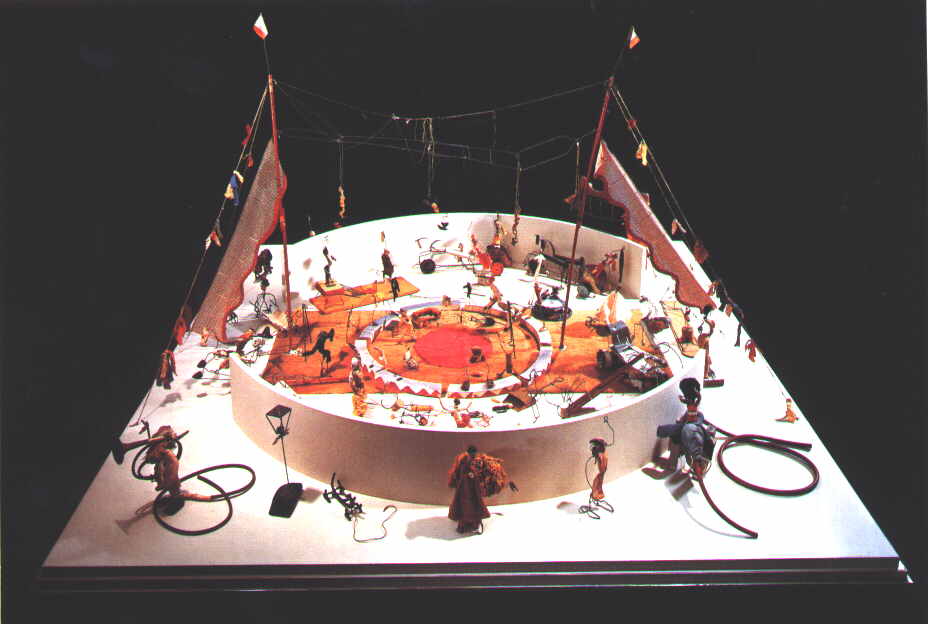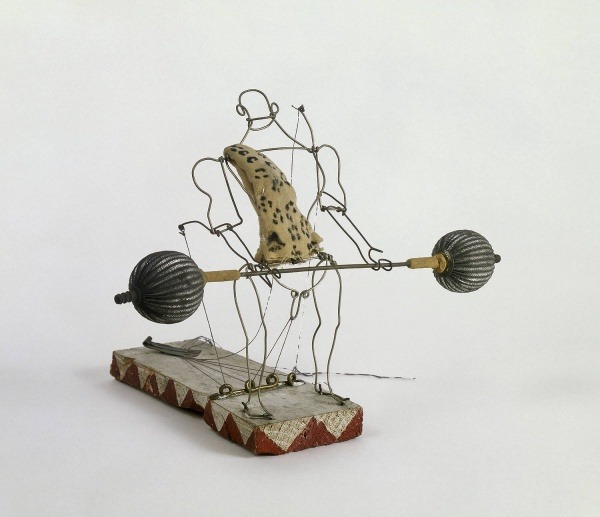The lesson plan I adapted was a
collaborative sculpture project based on Alexander Calder’s wire circus. The
concept theme is based on performance and Students are expected to create an
original character for a collaborative class installation. This lesson lacked
strategies and the students did not utilize digital technologies during this
project.
This particular project was one of
my favorites when designing and making the sample product for my art methods
class. But now, reviewing the teaching strategies and technologies in my
Alexander Calder lesson, I have discovered revisions and additives that can be
used to transform and transcend this already exciting lesson.
While
reflecting on Alex Calder lesson plan I realized my Canvas lesson, which was an
introduction of Claymation, would merge perfectly with my chosen lesson. Both
lessons incorporate technology and performance.
To begin this fusion I would first
identify the artist in which the students project stems from, Alexander Calder.
A slide show lecture would be presented accompanied by example videos on
Youtube as well as a documentary video. This combination of technologies would
help students graphically organize, which would help them to understand the
many influences and progressions of technology that changed Alex Calder’s work.
Learning about the artist and his work will also begin to inspire the students
creative thinking.
Students would then complete the
KWL charts for both the teacher and students to track and assesses development
and understanding that has been achieved. This will help to reach learning
targets and reassess and evaluate students learning and the lesson plan.
Next students would be given a
Frayer Model based on the word Performance; each student would complete this
sheet individually. A group discussion would be held based on the Frayer Model,
making connections between the similarities and differences students shared.
The teacher will guide students critical thinking using probing questions.
Students would then have a change
to begin to research many types of performances, along with finding more
information about Alexander Calder’s work.
The graphic Organizer would also be
used during this exercise to help students analyze and synthesize this
information into the planning of their character.
For homework students would then
begin to brainstorm and plan by drawing four possible characters they would
consider creating; as well as collect some objects that would aid in the
production of their character.
At the start of class students
would be given a demonstration using a document projector so
student can remain seated and still see a close up of the exact procedures being performed. During the demonstration the teacher would answer any question, while simultaneously asking students questions to check for understanding. The students will be provided with a checklist to ensure all elements and guidelines are included in their project so they can create a successful product. Students choose a character from their homework assignment and begin creating their character from metal wire and various found objects. At this time students still will have access to the Internet for any further referencing.
student can remain seated and still see a close up of the exact procedures being performed. During the demonstration the teacher would answer any question, while simultaneously asking students questions to check for understanding. The students will be provided with a checklist to ensure all elements and guidelines are included in their project so they can create a successful product. Students choose a character from their homework assignment and begin creating their character from metal wire and various found objects. At this time students still will have access to the Internet for any further referencing.
This next stage of the integrated
lesson involves the use of elements from both lesson plans. During this time
the teacher will give a brief demonstrations and lecture to inform
students on
how to use the cameras, allowing students to begin planning. Students will
begin by brainstorming during a group discussion while comparing and contrasting
ideas using storyboards. Students will break into individual groups, where
specific jobs will be assigned to ensure the process of the production runs
smoothly.
For the completed project students
will have created a cohesive and original class film. The film will incorporate
all of their characters in the performance by using video cameras and editing
programs on the computer. During the final stage the students will all participate
in making editing decisions. When finished students will also upload the video
to their individual blogs as well Youtube.
For the final stage a reflective
group critique and discussion will be conducted to review the KWL charts they
completed in the beginning of the project as well as their personal and
collaborative projects. This will allow the teacher and students to assess
their successes and progress that will also be reflected on the student’s exit
cards. Students are asked to post on at least three peers blogs, to communicate
their personal observations, thoughts, and feelings on the projects success,
individually and as a whole.
Overall this integrated technology
lesson demonstrates how the use of technology can enrich and transform lessons
in this new age of technology in the classroom.







Shannon, I really have enjoyed the creativity and style of your work across this course module. Your submissions are unique and it's clear that you are a budding art educator. Fort his final project, your matrix is generally in alignment across technologies, strategies and standards. At the same time, it's almost too dense and compacted and should probably be more like 8 rows instead of 5. The accompanying narrative is highly detailed as well. Although, the narrative does not seem to address all of the elements in your matrix, or maybe it doesn't use the same language? I could be wrong about that.
ReplyDeleteSpeaking of language, in moving beyond this course module, I'd like you keep something in mind. When you talk about your teaching—make it precise and intentional in terms of your strategy. An easy way to do this is to speak in active (rather than passive) voice. For example, instead of saying: "A slide show lecture would be presented accompanied by example videos on Youtube as well as a documentary video," phrase it as "I will present a mini-lecture using a slide show and illustrate examples through exemplar videos on YouTube and a documentary video." Similarly, instead of "Students would then complete the KWL charts," phrase it as: "I will assign/demonstrate for students how to complete KWL charts. . . and then use the data as informal assessment of. . . " I think you get the picture. This way, it is clear what YOU are accountable for as the teacher. It brings an intentionality and wisdom to your teaching.
Thank you for the feed back, I do need to work on my writing skills! Your examples are clear and will keep them in mind when writing documents related to my teaching career. This class helped me to gain extra tools I will use as an art educator!
ReplyDelete